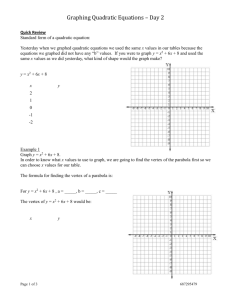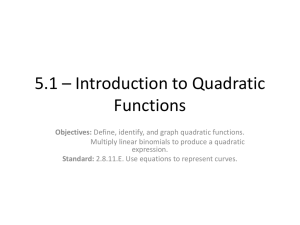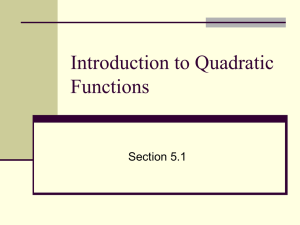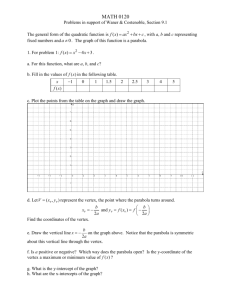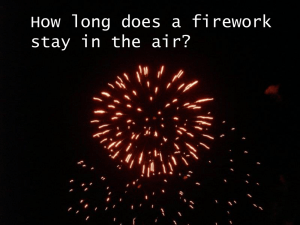Unit 3 Calendar
advertisement
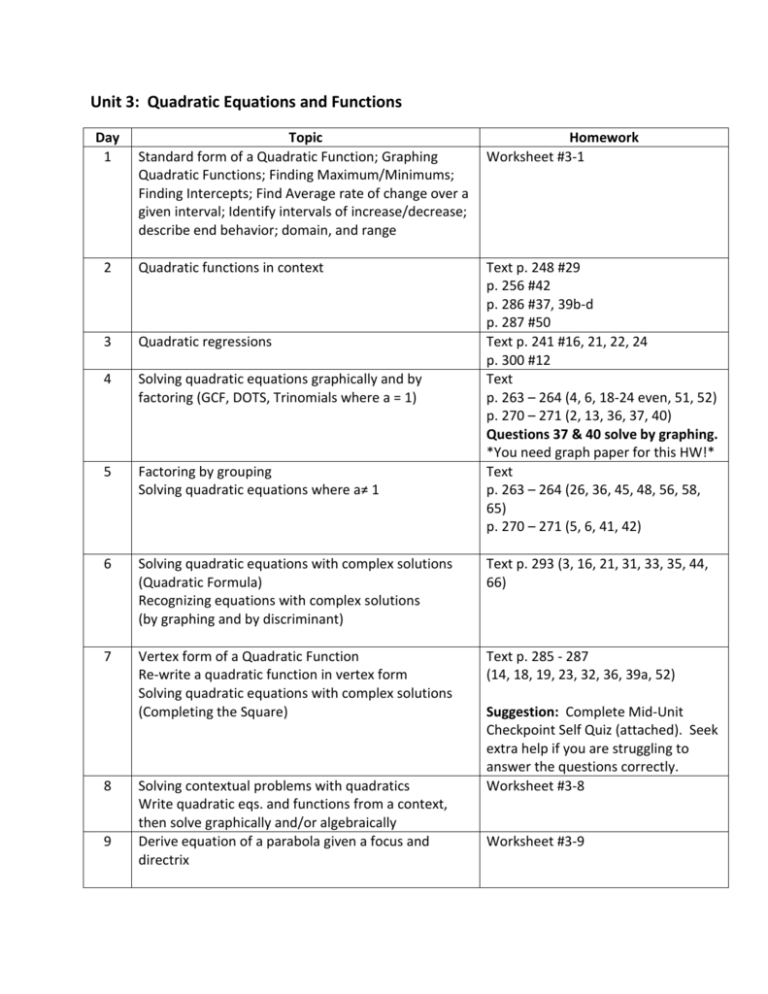
Unit 3: Quadratic Equations and Functions Day 1 Topic Standard form of a Quadratic Function; Graphing Quadratic Functions; Finding Maximum/Minimums; Finding Intercepts; Find Average rate of change over a given interval; Identify intervals of increase/decrease; describe end behavior; domain, and range Homework Worksheet #3-1 2 Quadratic functions in context 3 Quadratic regressions 4 Solving quadratic equations graphically and by factoring (GCF, DOTS, Trinomials where a = 1) 5 Factoring by grouping Solving quadratic equations where a≠ 1 Text p. 248 #29 p. 256 #42 p. 286 #37, 39b-d p. 287 #50 Text p. 241 #16, 21, 22, 24 p. 300 #12 Text p. 263 – 264 (4, 6, 18-24 even, 51, 52) p. 270 – 271 (2, 13, 36, 37, 40) Questions 37 & 40 solve by graphing. *You need graph paper for this HW!* Text p. 263 – 264 (26, 36, 45, 48, 56, 58, 65) p. 270 – 271 (5, 6, 41, 42) 6 Solving quadratic equations with complex solutions (Quadratic Formula) Recognizing equations with complex solutions (by graphing and by discriminant) Text p. 293 (3, 16, 21, 31, 33, 35, 44, 66) 7 Vertex form of a Quadratic Function Re-write a quadratic function in vertex form Solving quadratic equations with complex solutions (Completing the Square) Text p. 285 - 287 (14, 18, 19, 23, 32, 36, 39a, 52) 8 9 Solving contextual problems with quadratics Write quadratic eqs. and functions from a context, then solve graphically and/or algebraically Derive equation of a parabola given a focus and directrix Suggestion: Complete Mid-Unit Checkpoint Self Quiz (attached). Seek extra help if you are struggling to answer the questions correctly. Worksheet #3-8 Worksheet #3-9 10 Given the graph of a parabola, write its equation Worksheet #3-10 11 Solve 3 eqs with 3 unknowns Given 3 pts that lie on a parabola, find the eq. of the parabola in standard form Activity Unit Review Unit TEST Worksheet #3-11 12 13 14 Finish Day 12 Activity Study! None Worksheet #3-1 1. Graph y = -x2 – 4x + 12. Then identify the following key features. Vertex: Axis of symmetry: Maximum: Minimum: x-intercept(s): y-intercept: Domain: Range: End behavior: Interval(s) where the function is increasing: Interval(s) where the function is decreasing: OVER 2. Refer to the supplement if you forgot how to do questions 2 & 3. Read the scale carefully! 3. Calculate the average rate of change for the function over the interval [-4, -2]. Supplement – Review Average rate of change is essentially calculating the slope of the line between two points. Formula: Example: Calculate the average rate of change for the function f(x) = x2 + 6x + 9 between x = 1 and x = 3. First find the y-values when x = 1 and x = 3. You can do this by typing the equation in a graphs page and press control t for a table of values. Average rate of change: y 36 16 20 10 x 3 1 2 Worksheet #3-8 1. The fuel efficiency of a vehicle can be modeled with a quadratic function over a limited span of typical highway speeds. Suppose that a certain car has its best efficiency, 34 miles per gallon, at a speed of 42 miles per hour. At 70 miles per hour the efficiency is reduced to 20 miles per gallon. a. Write a quadratic function in vertex form that models the car’s efficiency. b. What speed(s) will result in an efficiency of 25 miles per gallon? c. Over what domain of speeds is this function a sensible model of fuel efficiency? Justify your answer. OVER 2. A certain fireworks rocket is set off at an initial upward velocity of 440 ft/s. This particular rocket is designed to explode at the height of 3000 ft. Assume the firework is set off at ground level. How many seconds does it take for the rocket to explode? 3. A soccer ball is kicked from the ground. After traveling a horizontal distance of 35 m, it just passes over a 1.5 m fence before hitting the ground 37 m from where it was kicked. See the diagram below. a. Determine the equation of a quadratic function that can be used to model the parabolic path of the ball. (Use factored form) b. How far has the ball traveled horizontally to reach the maximum height? c. Determine the maximum height of the ball. Worksheet #3-9 1. Write the equation of a parabola in standard form given a focus (0, -5) and directrix y = 5. 2. Write the equation of a parabola in standard form given a focus (-1, 0) and directrix y = 2. OVER 3a. Write the equation of a parabola in vertex form given a focus (-2, 1) and directrix y = -3. 3b. Determine whether or not the point (2, 1) is on the parabola. 4. Write the equation of a parabola in vertex form given a focus (-3, 7) and directrix y = 9. Worksheet #3-10 1. Analyze the graph below. Which function(s) could model the graph? Explain. f1 ( x) 2( x 1)( x 4) 1 f 2 ( x) x 2 3x 6 3 f3 ( x) 2( x 1)( x 4) f 4 ( x) 2 x 2 8.9 f5 ( x) 2( x 1)( x 4) f 6 ( x) ( x 6) 2 3 f 7 ( x) 3( x 2)( x 3) f8 ( x) ( x 6) 2 3 2a. Write the equation of the parabola shown on the right in factored form. OVER 2b. Rewrite the equation and put it in standard form. 2c. Check your answer by running a quadratic regression on your calculator. Use the 3 points on the parabola (-2, 0), (3, 0), and (4, -3) for the regression. Refer back to Day 3 Notes if you forgot how to do this. 2d. Using your answer from part b, rewrite the equation and put it in vertex form by completing the square. OVER 3a. Write the equation of the parabola below in vertex form. 3b. Rewrite the equation and put it in factored form. Worksheet #3-11 1. Determine the equation of the parabola that passes through the points (-2, 3), (-1, 1), and (1, 9). 2. Determine the equation of the parabola that passes through the points (-1, -4), (1, -2), and (2, -4). 3. Given a quadratic equation f(x) = ax2 + bx + c and f(3) = -6, f(1) = -2, and f(6) = 3. Find the equation. OVER 4. Solve the following system of equations: 3x 2 y 5 z 3 3x y 3z 4 3x 5 y 8 z 6 5. Solve the following system of equations: x 3y z 6 2 x 5 y z 2 x y 2 z 7


